Workation effects last for 4 weeks! Itoki releases demonstration experiment results in Setouchi
What is the "effect of workation on workers" as deciphered from the results of a total of five surveys conducted among 24 people in three groups by occupation?
ITOKI CORPORATION (Headquarters: Chuo-ku, Tokyo; President: Koji Minato), as a partner of the Setouchi Triennale 2022, conducted a demonstration experiment of workation with 24 employees, mainly in Naoshima and Teshima, during the autumn session.
The results of five questionnaire surveys conducted before and after the demonstration experiment confirmed that workcation in Setouchi improved work performance and well-being indicators, and that these effects lasted for four weeks. This experiment showed that having such opportunities on a regular basis for workers provides an opportunity to replenish energy in both work and well-being, and that there is ample potential for benefits to companies.
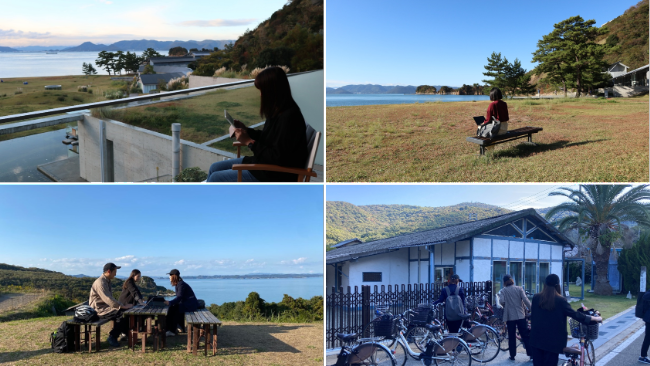
Research highlights
- Improvements in work performance and well-being indicators were seen. These effects last for 4 weeks.
- Creative occupations had a positive impact on ``subjective happiness,'' ``psychological stress,'' and ``motivation to grow at work,'' while other occupations had a positive effect on ``positivity at work.''
- Work performance is thought to be influenced by the content of the journey and the environment of the work place.
Investigation background
According to the Ministry of Land, Infrastructure, Transport and Tourism's "Fiscal 2021 Telework Population Survey Results" published on March 25, 2022, telework was the largest employment field in 2019, before the spread of the infectious disease, excluding self-employed workers. The percentage of employees in this type of employment who telework was 14.8%. However, it has continued to increase since 2020 and will increase by approximately 12 points to 27% in 2022.
In the future, as work styles become more diverse, it is likely that an increasing number of companies will consider introducing workation as an option.
Last year, Itoki was selected as a partner of the Setouchi Triennale 2022, in recognition of our approach to designing new ways of working and our activities to incorporate art into the office. On this occasion, we conducted a demonstration experiment to verify the effects and sustainability of workcations in Setouchi, where "art and nature" are fused.
Survey overview
- In order to observe changes before and after the workday, we conducted a workday experience for 2 nights and 3 days (some of which were 3 nights and 4 days), and conducted a total of 5 online questionnaire surveys before and after the experience.
- A total of 24 people participated in the verification in three groups, and each group conducted workcations on different dates and itineraries.
〇Implementation date|October 2022
〇 Verification procedure | Pre-survey: 1 time (1 week before), Post-survey: 4 times (immediately, 1, 2, 4 weeks later)
〇Research organization|Research outsourcing company: TATAMI Co., Ltd.
〇 Location: Mainly held in Naoshima and Teshima, the main venues of the Setouchi Triennale
〇Implementation scenery|
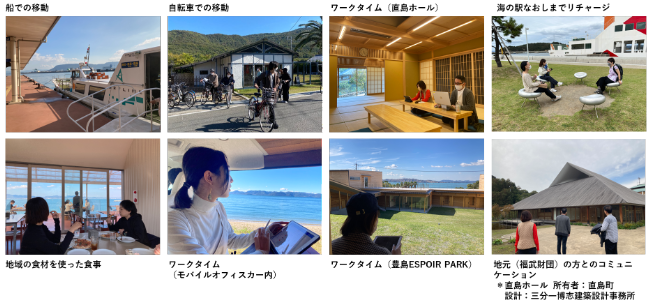
〇Workation style|
Hypothesizing that the extraordinary experience brought about by site-specific work (including the natural environment) on the islands of Setouchi will have a positive impact on workers, we set aside plenty of time to interact with the art of the islands, and Adopts a style of conducting daily work.
〇Participating groups|
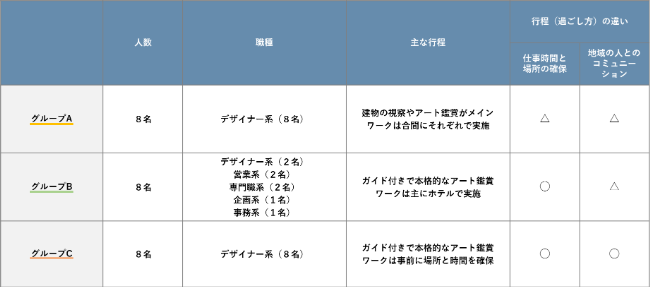
result
1. Motivation for growth increased by up to 22% compared to before implementation, and psychological stress decreased by up to 38%. Other effects remained better than baseline even after 4 weeks of implementation.
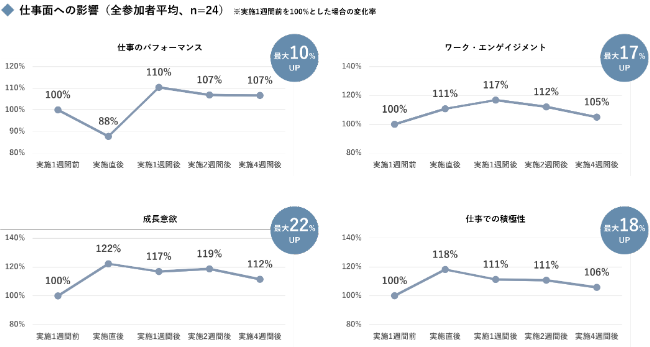
88% of participants answered that being exposed to nature and viewing high-quality art had a positive impact on their work. Possible reasons include being able to refresh the mind and body through contact with nature, and receiving inspiration and stimulation from art.
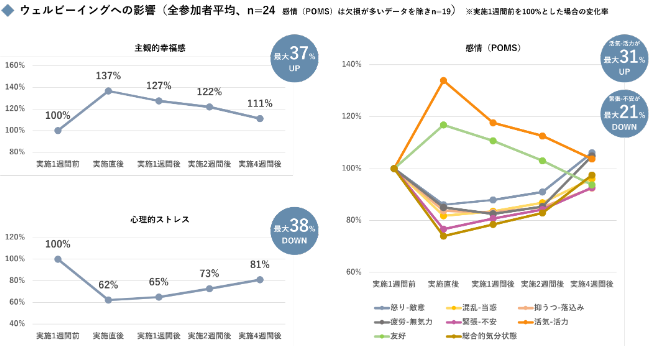
92% of participants said that opportunities to exercise had a positive impact on their well-being. It is thought that the cumulative effect of various experiences on the island, rather than any specific factor, led to improved well-being.
2. Looking at the results by job type, creative jobs are assumed to be positively influenced by ``subjective well-being'' and ``psychological stress,'' while other jobs are expected to be positively influenced by ``positivity at work.''
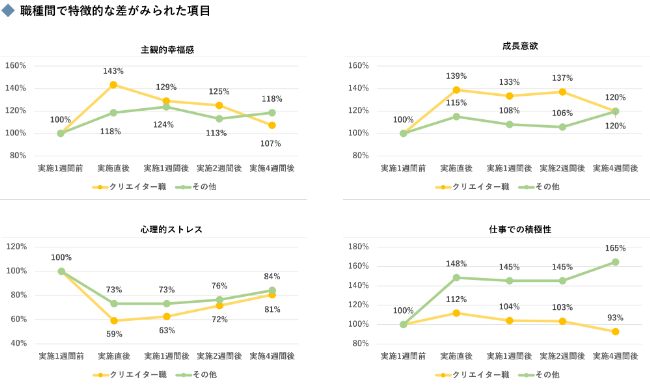
When it comes to subjective well-being and psychological stress, creative occupations (designers, etc.) are more positively affected than other occupations. For creators, it is possible that having a strong interest in and taste for art, such as by regularly going to art museums, may have had a more positive impact.
Compared to other occupations, creative workers showed an increased desire to grow and improve their own expertise after workcation. It is speculated that this is because exposure to artworks increased their motivation for their own creative activities. On the other hand, there was a greater improvement in proactiveness at work for other occupations than for creator occupations. After appreciating art, creators may want to pursue their specialty, while other workers may want to try something new and interesting.
3. Work performance is thought to be influenced by the content of the journey and the environment of the work place.
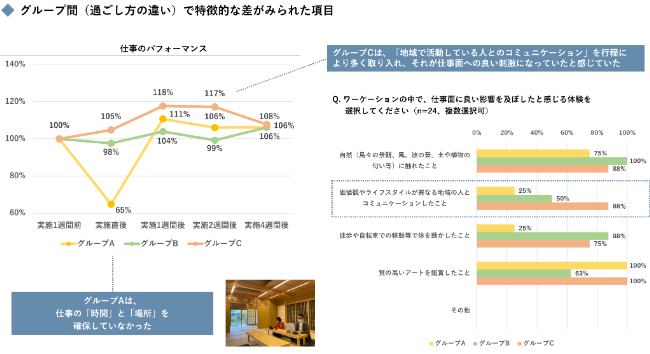
Looking at the results for each group, we can see that group A was most affected by the tendency for work performance to temporarily decline immediately after implementation. It is thought that the results reflect the fact that in Group A, it was difficult to work during workdays because they were unable to secure a place to work. It can also be seen that Group C maintained a higher level of work performance after implementation than the other groups. In Group C, 88% of participants answered that having more time to interact with local people had a positive impact on their work.
〇Measurement index|
We believe that the work experience at Setouchi can have an impact on both work and well-being of workers, and we believe that the work experience at Setouchi can have an impact on both work and well-being. Seven indicators were set for ``physical well-being, emotions, and mental stress''.
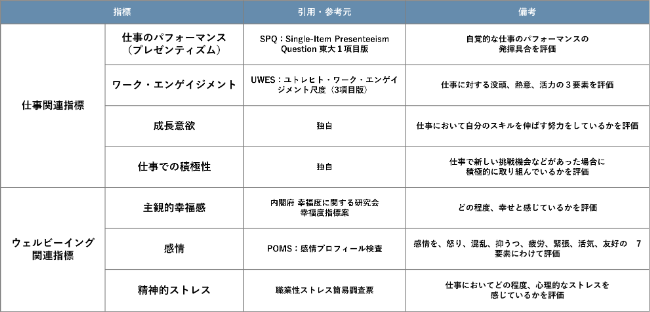
Summary
- As a result of the two-night, three-day work experience (some days, three nights and four days), improvements were seen in work performance and well-being indicators. Although these effects tended to gradually return to baseline, they were found to last for 4 weeks.
- The effect is thought to be the result of the large-scale art and the island environment, where you can slowly face it. In addition, creative workers with a strong taste for art are thought to be able to benefit more from Setouchi workcations. On the other hand, people in occupations other than creative workers showed a significant improvement in their proactiveness at work, which seems to have the effect of making them more motivated to take on new challenges.
- For workers, having such opportunities on a regular basis provides an opportunity to recharge both in terms of work and well-being, and a work style adopted regularly has the potential to be beneficial to the company. The results of this verification showed that there is.
[Comment from researcher Yoshiaki Takahara]
Approximately three years have passed since the COVID-19 pandemic began, and the way people work has steadily changed. Corporate culture and workers values have been renewed, coupled with the development of remote communication technology, and companies are now offering more flexible working options that are unrestricted by where they work. This study suggests that the use of workation can improve workers' well-being and work vitality, leading to corporate dynamism. In the future, as the use of this new way of working expands to more and more companies, this study also suggests differences in effects depending on job type and program, such as the affinity between Setouchi's art and creative workers. Based on this, I hope that the development of original programs and facilities that take advantage of regional characteristics will progress in various parts of Japan, and that diverse workplaces will spread across Japan.
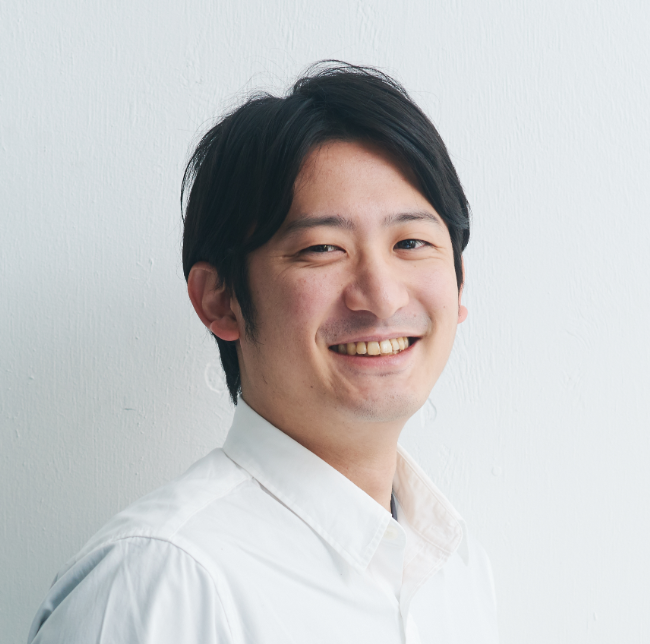
TATAMI Co., Ltd. Representative Director/Ergonomist Ryo Takahara
Responsible for consulting and research related to workplace construction. Specializes in research on workplaces and workers well-being. Part-time faculty member at Kuwasawa Design Institute, part-time lecturer at Chiba Prefectural University of Health and Medical Sciences.
TATAMI Co., Ltd. Home Page
About Itoki's Workplace Business
Since its founding in 1890, ITOKI CORPORATION has upheld the mission statement of "We Design Tomorrow. We Design WORK-Style." and has supported the creation of a wide range of “Space," “Environment," and “Place" with a wide lineup of office furniture, logistics equipment, ICT and audiovisual equipment, and building materials and interior equipment.
After the coronavirus shock, we regard the entire working space as “Work Environment”'' and in addition to products and services that create an environment where workers can ``work together,'' we have also expanded our efforts to provide ``distributed'' products and services such as home furnishings to facilitate remote work and home learning We support the creation of “Work Environment” in any space by providing a comprehensive range of products that support the working environment, as well as surveys and consulting services for corporate work style strategies and working environment improvements.
To this release
Contact information
株式会社イトーキ
CSR推進室
TEL:03-6910-3910
press personnel
Contact information
株式会社イトーキ
広報IR部
TEL:03-6910-3910
- The information posted is current at the time of publication. Please note that the information may differ from the latest information.
